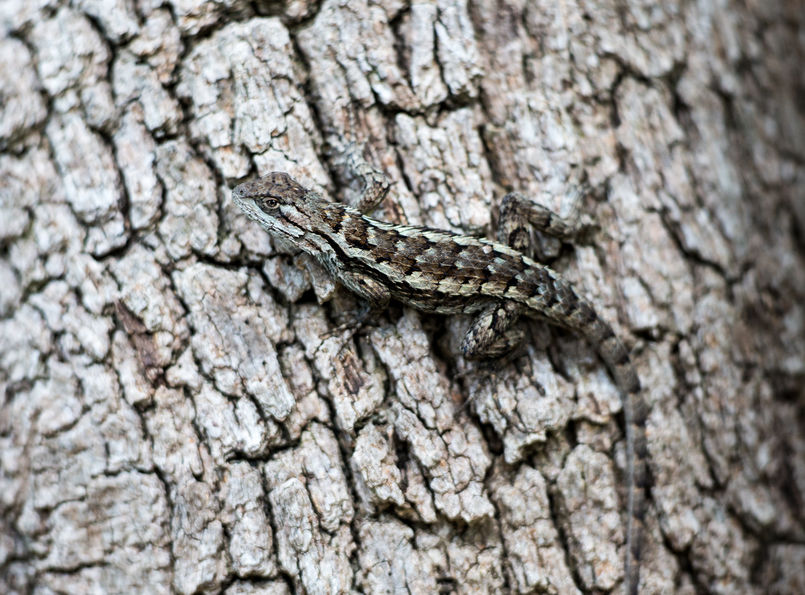Little Bit. That’s what a friend of ours called the Texas spiny lizard that would perch on her shoulder one summer at her grandparents’ place in Driftwood, Texas. There are online “how-tos” on keeping these curious little creatures as pets, but Little Bit was wild and autonomous. He would take advantage of the occasional open back door and scamper in to find his two-legged friend. They would kick back in the den’s recliner, maybe watch a bit of television, before Little Bit would dash away. They may not make for splashy headlines like the Texas horned lizard, but they’ve helped make fond memories for many a Texas kid. And more than one Texas gardener has spent some quality time talking to a Texas spiny lizard. Although always ready to zip up a tree (or out the back door), as it tilts its head and hovers nearby, a Texas spiny lizard can be companionable presence. As summer approaches, the odds of seeing (and chatting with) a Texas spiny lizard increase as they are mostly active during warm days. Like other lizards, Texas spiny lizards are coldblooded (don’t generate heat from inside of their body, they need outside sources). While we may seek out the shade of a porch and a cold lemonade during summer, a Texas spiny lizard will happily claim a spot in the sun and bask on a hot rock.
Also called “tree lizards” or “fence lizards” these grayish to brownish Texas natives are easily identified by their scaly—spiny—appearance. Adults are frequently 11 inches in length, which includes a 4 to 5-inch tail, just one of the features that helps distinguish it from the much shorter-tailed horned lizard. As described in “Wild About Texas: Texas spiny lizards harmless, helpful”:
“The tail is quite long and, as with other members of its genus, it can be used as a defensive strategy. If the tail is grabbed by a predator, it is easily severed from the lizard, a defensive move known as autotomization. The tail comes off rather easily, and while the potential predator is preoccupied with the still moving tail, the lizard can crawl to safety. Over time the lizard will regenerate a new tail, although this new one is never as long or colorful as the original.”
(Many of us with backyards and prey-driven little dogs, are familiar with a lizard’s autotomization.)
The male spiny lizards are distinguished from their female counterparts thanks to a sliver of bright blue coloring on either side of the belly. Breeding occurs in early spring. As described by “Master Naturalists Texas spiny lizards give us a garden surprise”:
“They’re not ground dwellers, but spiny lizards nest on the ground like most reptiles. Mated females select a spot with fairly dry, loose soil, good sun exposure and dig a slanted hole about 5- to 6-inches deep and about 4-inches wide.
“Females back into their hole and deposit eight to 30 cylindrical, leathery eggs, one half of an inch long, and one fourth of an inch in diameter. After refilling the hole, hiding the eggs, they never return to the nest. The eggs will hatch in between 43 to 83 days.”
Females may lay up to four clutches of eggs in a summer and typically do not move more than 30 meters from their nesting sites in a lifetime. In addition to allowing native gasses and wildflowers time to go to seed, mowing should be avoided during wildlife nesting periods to help provide cover and protect a wide variety of ground nesters, including Texas spiny lizards.
Upon hatching, the young spiny lizards emerge about 2-3 inches long and ready to fend for themselves. The carnivorous lizards eat a variety of insects including wasps, grasshoppers, and beetles.
One “how-to” on keeping a Texas spiny lizard as a pet describes a lifespan of “around seven years,” but out in the wild, the lifespan may be much shorter, one source put the “average lifespan” at “20.6 months.” After that one summer in Driftwood, Little Bit wasn’t seen again. Maybe he was nearing the end of his 20.6 months or maybe he found another recliner and another shoulder to perch on.









